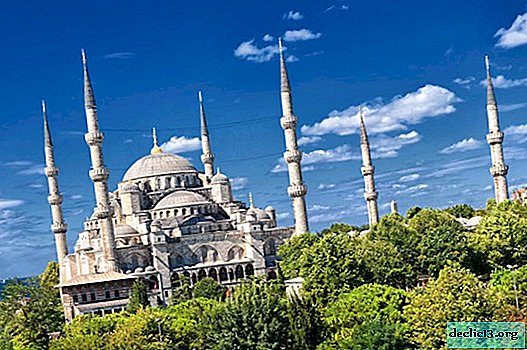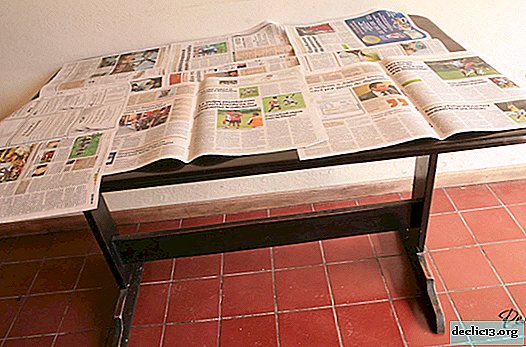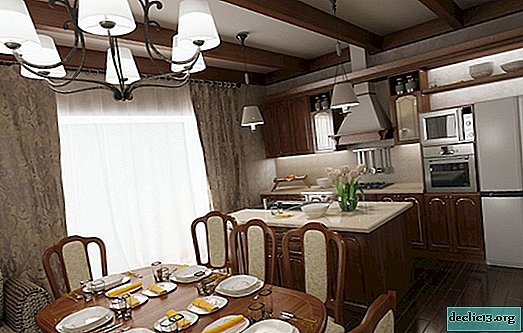Blue Mosque: an unusual story of the main shrine of Istanbul
The Blue Mosque is the first most important mosque in Istanbul, which is also one of the main symbols of the city and Turkey itself. Built in difficult times for the Ottoman Empire, the temple embodied the interweaving of Byzantine and Islamic architectural styles, and today the building is recognized as an exemplary masterpiece of world architecture. Initially, the mosque was called Sultanahmet, in whose honor the area where it is located was named. But today the building is often called the Blue Mosque, and this name is directly related to the interiors of the shrine. A detailed description of the temple and practical information about it you will surely find in our article.

History reference
 Sultana Ahmed
Sultana AhmedThe beginning of the 17th century became a tragic page in the history of Turkey. Having unleashed two wars at once, one in the west with Austria, the other in the east with Persia, the state suffered defeat after defeat. As a result of the Asian battles, the empire lost the recently conquered Transcaucasian territories, losing them to the Persians. And the Austrians achieved the conclusion of the World of Life, according to which obligations were made from Austria to pay tribute to the Ottomans. All this led to a decline in the authority of the state on the world stage, and in particular, undermined the status of its ruler - Sultan Ahmed.
 Zedefkar Mehmet Aga
Zedefkar Mehmet AgaDejected by the situation, the young padishas in despair decides to erect the most grandiose structure that the world has not yet seen - the Sultanahmet mosque. To carry out his ideas, Vladyka called on the apprentice of the famous Ottoman architect, Mimar Sinan, an architect named Zedekkar Mehmet Aga. To erect the structure, they chose the place where the Great Byzantine Palace once stood. The building and the buildings adjacent to it were destroyed, and part of the seats left at the Hippodrome were also destroyed. The construction of the Blue Mosque in Turkey began in 1609 and ended in 1616.
Now it’s hard to say what motives Sultan Ahmed was guided by when deciding on the construction of a mosque. Perhaps in this way he wanted to receive the mercy of Allah. And, perhaps, he wanted to establish his power and make the people forget about him as a sultan who did not win a single battle. It is curious that just a year after the opening of the shrine, the 27-year-old padishah died of typhus.

Today, the Blue Mosque in Istanbul, whose history of construction is very ambiguous, is the main temple of the metropolis, accommodating up to 10 thousand parishioners. In addition, the building has become one of the most popular attraction among the guests of Turkey who visit the object, not only because of its scale, but also because of the unique beauty of its interior decoration.
Architecture and Interior

When designing the Blue Mosque, the Turkish architect took Hagia Sophia as a model. After all, he was faced with the task of building a shrine, more magnificent and larger than all the structures that already existed at that time. Therefore, in the architecture of the mosque today, one can clearly see the interweaving of two architectural schools - the styles of Byzantium and the Ottoman Empire.
During the construction of the building, only expensive types of marble and granite were used. The basis of the mosque was a rectangular foundation with a total area of more than 4600 m². In its center is the main prayer hall with an area of 2700 m², and it is covered by a large dome with a diameter of 23.5 m, located at a height of 43 m. Instead of the standard four, six minarets were installed in the temple, each of which decorates 2-3 balconies. The blue mosque inside is distinguished by good natural light, which is facilitated by its 260 windows, 28 of which are on the main dome. Most of the windows are decorated with stained glass.

The interior of the building is dominated by lining from Iznik tiles: here there are more than 20 thousand. The main shades of the tiles were white-blue tones, due to which the mosque acquired its second name. The decor of the tiles themselves reveals mainly plant motifs of flowers, fruits and cypresses.

The main dome and walls are decorated with gilded inscriptions in Arabic. In the center is a huge chandelier with dozens of lamps, garlands of which also stretch around the entire perimeter of the room. Old carpets in the mosque were replaced with new ones, and red shades with blue ornaments prevail in their color scheme.

In total, the temple has six entrance doors, but the main one, through which tourists go inside, is located on the side of the Hippodrome. It is important to note that this religious complex in Turkey includes not only a mosque, but also madrassas, cuisines and charitable institutions. And today, only one photo of the Blue Mosque in Istanbul is able to excite the imagination, but in reality the structure strikes even minds that are not knowledgeable in architecture.Find out RATES or book any accommodation using this form
Rules of behavior
When visiting a mosque in Turkey, you must follow a number of traditional rules:

- Women are allowed inside only with their heads covered. Hands and feet should also be hidden from prying eyes. Those who come in improper form are given special clothing at the entrance to the temple.
- Men must also follow a specific dress code. In particular, they are forbidden to attend the mosque in shorts and T-shirts.
- At the entrance to the Blue Mosque in Istanbul, you need to take off your shoes: shoes can be left at the door or taken with you, put in a bag.
- Tourists are allowed to go to mosques only along the edges of the building, only worshipers can enter the center of the hall.
- It is forbidden to go over fences in the room, talk loudly, laugh, or prevent believers from praying.
- Tourists are allowed to visit a mosque in Turkey only in between prayers.
On a note: 10 best excursions in Istanbul - with which guide to go for a walk.
How to get there

There are several ways to get to this Istanbul landmark in Turkey. The most straightforward of them is a taxi, of which a great many travel around the city. The fare for boarding passengers is 4 TL, and for each kilometer you will have to pay 2.5 TL. Calculating the cost of the trip is quite simple by learning the distance from your starting point to the object.

From the central areas of Istanbul, you can also get to Sultanahmet Square, where the Blue Mosque is located, by tram. To do this, you need to find a tram station on the T1 line Kabataş - Bağcılar and land at the Sultanahmet stop. The temple building will be located just a couple of hundred meters.
You can get to the mosque from the Besiktas district by the TB1 city bus, which runs along the Sultanahmet-Dolmabahçe route. A bus from line TB2 also runs from Uskudar County in the direction of Sultanahmet - Çamlıca.
Read also: Istanbul metro features - how to use, layout and prices.
Compare accommodation prices using this form
Practical information
- Address: Sultan Ahmet Mahallesi, Atmeydanı Cd. No: 7, 34122 Fatih / İstanbul.
- Opening hours of the Blue Mosque in Istanbul: from 08:30 to 11:30, from 13:00 to 14:30, from 15:30 to 16:45. On Fridays opening from 13:30.
- Cost of visit: is free.
- Official site: www.sultanahmetcamii.org
Useful Tips
If you plan to look at the Blue Mosque in Istanbul in Turkey, we advise you to pay attention to the list of recommendations made by us, which are based on the opinion of travelers who have already visited the property:

- On Fridays, the mosque opens later, which creates large crowds of tourists at the entrance. Therefore, it is best to visit the temple another day. But this does not guarantee you the absence of queues. Ideally, you should go to the building by 08:00 - half an hour before the opening.
- It is not forbidden to take a photo in the Blue Mosque, but you should not take pictures of worshipers.
- Currently (autumn 2018), restoration work is being carried out in this building in Turkey, which, of course, can somewhat spoil the impression of the attraction. So plan your trip to Istanbul with this in mind.
- Although women are given long skirts and scarves at the entrance, we recommend taking your own things with you. Firstly, clothes are provided intermittently, and secondly, large lines often accumulate at the pick-up point.
- In general, you will need no more than an hour to inspect the temple.
Interesting Facts
Interesting facts about the Blue Mosque of Istanbul open the veil of secrets and allow us to look at the history of Turkey from a different angle. We selected the most curious of them:
- Since Sultan Ahmed could not win in any major battle and win trophies, the state treasury was completely unprepared for the construction of such a large-scale structure as the Sultanahmet Mosque. Therefore, the padishah had to allocate funds from his own treasury.
- During the construction of the mosque, the sultan demanded that Iznik factories supply only the most skilled tiles. At the same time, he forbade them to supply other construction objects with tiles, as a result of which factories suffered great losses and reduced the quality of the tiles produced.
- After the construction of the Blue Mosque in Turkey, a real scandal erupted. It turned out that the temple in terms of the number of minarets approached the main Islamic shrine, Masjid Al-Haram in Mecca, which at that time was part of the Ottoman Empire. The Padishah solved this problem by allocating funds for the extension of the seventh minaret to the Al-Haram Mosque.
- On the lamps in the building you can see ostrich eggs, which serve as a means of combating cobwebs. According to one legend, the spider once saved the prophet Mohammed and now the killing of this insect is regarded as a sin. To get rid of spiders in a humane way, Muslims decided to use ostrich eggs, the smell of which can repel insects for decades.
- Another interesting fact about the Blue Mosque is connected with Pope Benedict XVI. In 2006, only the second time in the history of the Catholic Church, the pope visits an Islamic shrine. Following the accepted traditions, the pontiff in front of the temple was swollen, and after spending some time in meditation next to the main mufti of Istanbul.


Output
The Blue Mosque in Turkey is a must-see attraction in Istanbul. Now that you have learned about its history and decoration, your tour of the shrine will be much more exciting. And for her organization to be held at the highest level, be sure to use the practical information and our recommendations.

















